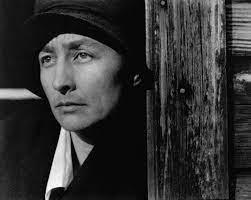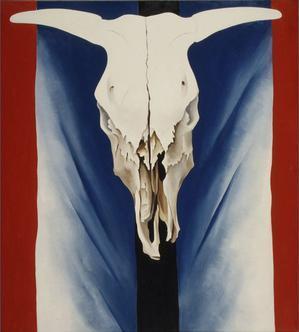Identifying Creator of Cultural Works

Georgia O’Keeffe is one of the notable American painters who revolutionized art in the 20th Century. Born on November 15, 1887, O’Keeffe attended various Chicago and New York art schools before becoming a commercial instructor. As a fan of oriental art, she started her career in 1905 after joining the School of the Art Institute of Chicago. O’Keeffe won several prizes throughout her education and attended art galleries in the United States, which inspired her. Notably, she frequented the Little Galleries of the Photo-Secession that Alfred Stieglitz, O’Keeffe’s future husband, co-owned. Across the globe, many artists refer O’Keeffe as the inventor of “American Modernism” because of her professional use of imitative realism to express various contexts of society.
O’Keeffe acquired the modernist perspective from her associate, Arthur Wesley Dow. She explored Dow’s principles and replicated them in her paintings. She remained independent as art trends shifted, and aimed at multiple compositions instead of mere representation. O’Keeffe’s art comprised radical depictions of modern ideas translated into stylistic color palettes. Before her demise in 1986, O’Keeffe had curved her skill around New Mexico landscapes, New York skyscrapers, and enlarged blooms. America honored O’Keeffe with a museum located in Santa Fe, which exhibits her notable works and preserves her artistic legacy.
Describing One Cultural Work

The Cow’s Skull: Red, White, and Blue painting is a significant example of O’Keeffe’s precisionist artworks. She created the art of a single skull that looks devoured or eroded by weather. During O’Keeffe’s regular retreats outside New York City, she spotted a similar skull or acquired the idea. Even though O’Keeffe collected bones for fun, her painting suggested more than a mere depiction of the desert environment. During an interview, she confesses that “the bones seem to cut sharply to the center of something that is keenly alive in the desert even though it is vast and empty and untouchable” (Pounders, 2019).
This oil on canvas infers to the evanescence of life from the inspirations O’Keeffe acquired in New Mexico. It represents naturalism and the beauty of the desert. The Cow’s Skull illustrates the American spirit of endurance inspired by The Great American Poetry. Red, white, and blue represent the national flag, showing O’Keeffe’s patriotism and respect for American History. This canvas utilized two revolutionary approaches that facilitated the advancement of modernism; O’Keeffe borrowed ideas from Cubism and Futurism, deconstructing life along multiple planes.
Determining Questions About Human Culture
O’Keeffe’s painting prompts various questions concerning human culture and the evolutionary approaches that modern artists apply. In contrast to 20th Century painters, modern artists have invested in advanced pedagogies that vary from precisionist exhibit in this painting. First, The Cow’s Skull prompts the question, “how have modern American painters promoted patriotism in their contemporary works?” Due to the shift in the cultural significance of art due to modernization and globalization, this masterpiece suggests that painters should reflect on their styles to appreciate history and support national development. Secondly, this work asks, “what is the relationship between nature and humans?” The Cow’s Skull exhibits a deep connection between animals (nature) and human beings.
In the painting, O’Keeffe displays a weathered skull at the center of a piece of cloth which could represent Americans’ way of life. Its context shows that nature dominates over humans, and people should acknowledge it regardless of the perennial challenges symbolized by a weathered muzzle. Thirdly, O’Keeffe’s painting prompts the question of communication and how artists can harness their skills to relay meaningful messages to society. In an era of reduced linguistic use due to digitization, The Cow’s Skull asks modern artists whether they can integrate cultural elements in their work to enhance identity and meaning. With indigenous ways of life facing extinction, the painting prompts a societal analysis of the cultural aspects such as art and how significant they are to the respective communities.
Defining Big Questions
The primary inspiration for The Cow’s Skull was drought; after taking several retreats across the Southwest, O’Keeffe witnessed the devastation as animal skeletons littered the landscape. She wanted to address climate change, considering that cows were native animals in her toured areas. Weathered bones and skulls inspired O’Keeffe to create a painting that would resonate with the situation and possibly prompt Americans and the rest of the world to take action. The sight of dead animals and decaying body parts invoked emotions that promoted the painting.
At the time, The Great Depression negatively affected Americans and their way of life. According to Hall and Matthews (2020), The Great Depression had resulted in the loss of livelihood, and “that economic crisis ended much of the philanthropy and other support that had allowed black artists to experiment with their crafts (p.3). The pinnacles and hollows of the partially-weathered cow’s skull related to America’s tolerance during the Depression. Even though the economy was trailing, the nation maintained its identity. Through a precisionist pathway, O’Keeffe created a painting that manifested naturalism and quenched the human need for expression through borrowed principles of Cubism and Futurism.
References
Pounders, L. A. (2019). Her “Symbols of the Desert”: An Emerging Alchemical Impression in the Bone Paintings of Georgia O’Keeffe. Journal of Jungian Scholarly Studies, 14, 16-29. Web.
Hall, J., & Matthews, A. (July 1, 2020). Harlem’s renaissance. Cobblestone.
O’Keeffe, G. (1931). Cow’s Skull: Red, White, and Blue. The Metropolitan Museum of art. Web.
Stieglitz, A. (1922). Photograph of Georgia O’Keeffe. Art Institvte Chicago. Web.